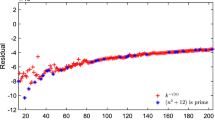Abstract
Continued fractions D(a, x) were used in the analysis of the highly excited (J ≤ 42, K a ≤ 32) rotational levels of the first eight vibrational states of a H2 16O molecule. The fractions depend on the rotational operator J z , defined by the variable x, and the shape parameter a, which determines the asymptotic behavior of the calculated energy levels. Continued fractions D(a, x) are new forms of the generating functions for the effective rotational Hamiltonian of some nonrigid molecule of the H2X type.
Similar content being viewed by others
References
V. I. Starikov and Vl. G. Tyuterev, Intramolecular Rovibrational Interactions and Theoretical Methods in the Spectroscopy of Nonrigid Molecules (Spektr, Tomsk, 1987) [in Russian].
A. D. Bykov, L. N. Sinitsa, and V. I. Starikov, Experimental and Theoretical Methods in Spectroscopy of Water Vapor (Sib. Otd. Ross. Akad. Nauk, Novosibirsk, 1999) [in Russian].
P.-F. Coheur, P. F. Bernath, M. Carleer, R. Colin, O. L. Polyansky, N. F. Zobov, S. V. Shirin, R. J. Barber, and J. Tennyson, “A 3000 K Laboratory Emission Spectrum of Water,” J. Chem. Phys. 122, 074307 (2005).
V. I. Starikov and Vl. G. Tyuterev, “On New Shape of Rotational Hamiltonian of Nonrigid Asymmetric Spinner,” Opt. Spektrosk. 59, 473–474 (1985).
H. Partridge and D. W. Schwenke, “The Determination of an Accurate Isotope Dependent Potential Energy Surface for Water from Extensive Ab Initio Calculations and Experimental Data,” J. Chem. Phys. 106, 4618–4639 (1997).
V. I. Starikov and S. N. Mikhailenko, “Expansion of the Generating — Function Approach for Non-Rigid X2Y-Type Molecules by Means of the Borel-Type Summation Method,” J. Phys. B 33, 1–12 (2000).
Vl. G. Tyuterev, “The Generating Function Approach to the Formulation of the Effective Rotational Hamiltonian: A Simple Closed Form Model Describing Strong Centrifugal Distortion in Water-Type Nonrigid Molecules,” J. Mol. Spectrosc. 151, 97–129 (1992).
I. S. Gradshtein and I. M. Ryzhik, Table of Integrals, Series and Products (Academic, New York, 1980; Gosfizmatlitizdat, Moscow, 1962).
V. I. Perevalov and Vl. G. Tyuterev, “Reduction of the Centrifugal Distortion Hamiltonian of Asymmetric Top Molecules in the Case of Accidental Resonances: Two Interacting States. Lower-Order Terms,” J. Mol. Spectrosc. 96, 56–76 (1982).
J. Tennyson, N. F. Zobov, R. Williamson, and O. L. Polyansky, “Experimental Energy Levels of the Water Molecule,” J. Phys. Chem., Ref. Data 30, 735–831 (2001).
Author information
Authors and Affiliations
Additional information
Original Russian Text © V.I. Starikov, 2010, published in Optica Atmosfery i Okeana.
Rights and permissions
About this article
Cite this article
Starikov, V.I. The use of continued fractions to describe the highly excited rotational states of a H2O molecule. Atmos Ocean Opt 23, 165–168 (2010). https://doi.org/10.1134/S1024856010030012
Received:
Published:
Issue Date:
DOI: https://doi.org/10.1134/S1024856010030012



